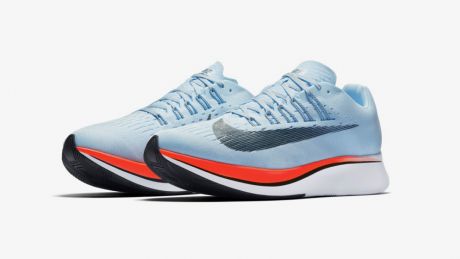You can trust Coach
The start line of any major running event is a great place to scout out your next pair of running shoes since, in theory, those around you will be runners of a similar ability wearing their race-day favourites. However, over the next 12 months this start-line scouting might get a bit samey, because you can expect the Nike Zoom Fly to be adorning the feet of a disproportionate amount of runners.
Part of that is down to hype. Since Eliud Kipchoge came within a whisker of breaking the two-hour-marathon barrier in May, runners have been keenly awaiting versions of Nike’s special shoe to appear in shops.
The Zoom Vaporfly 4% is the closest consumers can get to the shoe Kipchoge wore (the actual elite version of the shoe is not for sale) but at £199.95 it requires a hefty outlay. At £129.95, the Zoom Fly, which uses similar technology, is still far from cheap, but it’s more accessible to everyday runners.
The key piece of tech in the Zoom Fly inspired by Nike’s Breaking2 project is a full-length, carbon-infused nylon plate in the midsole which helps propel you forward when running. For those deciding between the two versions available to consumers, the Vaporfly 4% has the same plate, but it’s made of carbon fibre, which is the main reason the Vaporfly (184g) is much lighter than the Zoom Fly (248g).
However, the Zoom Fly is hardly a heavyweight and you can definitely feel the effect of the plate when running. When you first go out in the Zoom Fly it’s slightly disconcerting how much it throws you forward, but I found that after a couple of runs that I either got used to the feeling or the shoe settled down. It’s quite a stiff shoe so needs some breaking in.
See related
- The Best Nike Running Shoes For Every Type Of Runner
- Six Things Every Runner Can Learn From Nike’s Breaking2 Two-Hour Marathon Attempt
- The Best Running Shoes Of 2021

After a couple of runs it no longer felt like I was off-balance, but the transition was still quick and smooth. You can feel the benefit of runs of any length and on any hard terrain. I threw pretty much everything at it – 400m sprints on the track, one-mile races on road and track, a 10K on a riverside trail and a half marathon – and the Zoom Fly never disappointed. It’s fast, responsive and comfortable over long distances.
Of the runs I did in the Zoom Fly, it was the half marathon in particular where it shone – it makes holding a fast pace for long stretches feel easy. Well, easier. I’m sure it will be the first-choice of many runners for half and full marathons over the next year.
The upper on the Zoom Fly is breathable and light, with Ultralight Flywire cables providing a secure fit around the heel and midfoot. It feels snug but the upper moves with the foot to stop it feeling constrictive.
Very keen and fast runners might splash out for the lighter Vaporfly 4%, but I’d say the Zoom Fly is already pretty much a perfect shoe for pacy amateurs, especially those seeking a PB at half and full marathon distance. It’s expensive, and I have some concerns about how durable the Zoom Fly will prove to be based on the wear and tear I saw after just 50 miles, but the hype around Nike’s Breaking2-inspired shoes is justified.
£125, buy on runnersneed.com

Nick Harris-Fry is a journalist who has been covering health and fitness since 2015. Nick is an avid runner, covering 70-110km a week, which gives him ample opportunity to test a wide range of running shoes and running gear. He is also the chief tester for fitness trackers and running watches, treadmills and exercise bikes, and workout headphones.

